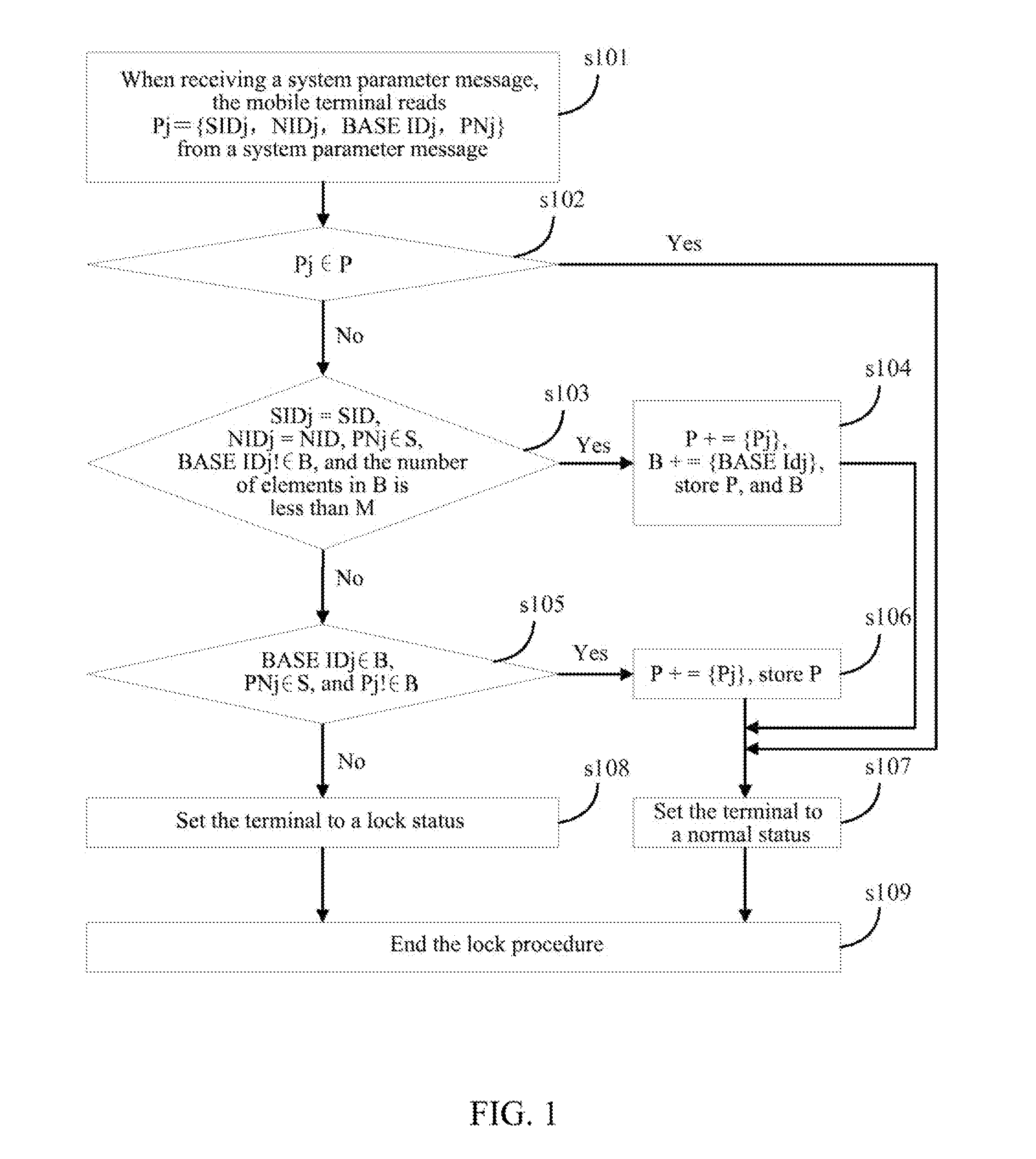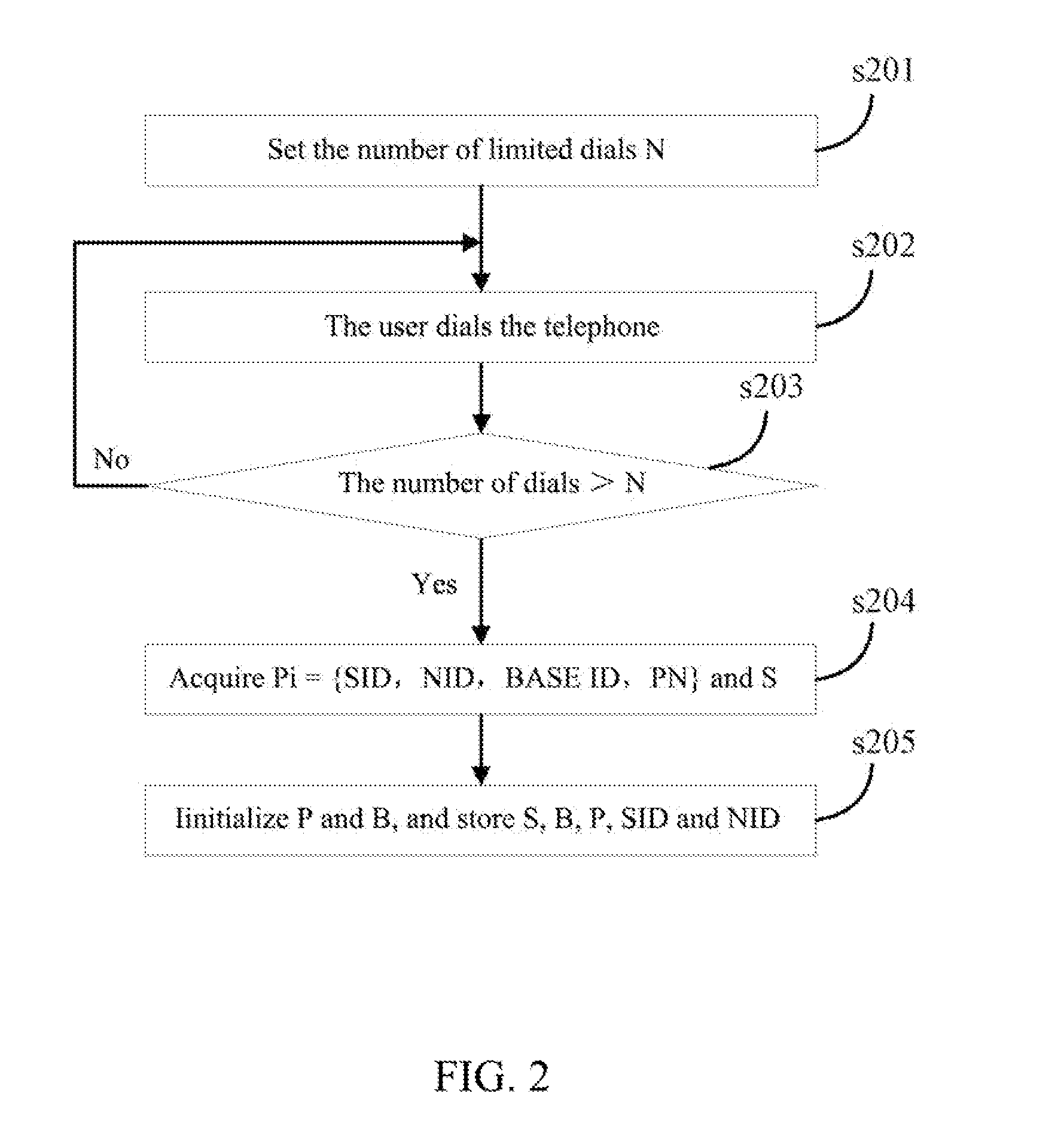Cell Locking Method for Mobile Terminal and Mobile Terminal Capable of Locking Cell
a cell and mobile terminal technology, applied in the field of wireless communication, can solve the problems of affecting the service provided by the terminal, increasing interference, reducing the coverage area of the base station, and reducing the cost of operation, so as to achieve the effect of reducing the operating cos
- Summary
- Abstract
- Description
- Claims
- Application Information
AI Technical Summary
Benefits of technology
Problems solved by technology
Method used
Image
Examples
example 1
[0028]A cell locking method for a mobile terminal in the example of the present invention is as shown in FIG. 1 and includes the steps as follows.
[0029]Step s101. The mobile terminal searches a cell at a current location, and the mobile terminal, when receiving a system parameter message, reads Pj={SIDj, NIDj , BASE IDj, PNj} from the system parameter message.
[0030]Step s102. It is judged whether Pj belongs to P; if yes, then transfer to step s107, otherwise transfer to step s103.
[0031]Step s103. It is judged whether SIDj=SID, NIDj=NID, PNj∈S, BASE IDj !∈B, and the number of elements in B is less than the maximum number M of the BASE ID simultaneously supported by the user terminal, if yes, then transfer to step s104, otherwise transfer to step s105.
[0032]Step s104. Pj is added to the set P, i.e. P+={Pj}; BASE IDj is added to set B, i.e. B+={BASE IDj}; B and P are stored, and transfer to step s107.
[0033]Step s105. It is judged whether BASE IDj∈B, PNj∈S, and Pj!∈P, if yes, then trans...
example 2
[0038]Before example 1, the present invention further includes an initialization procedure, and the flow of the initialization procedure in the example of the present invention is as shown in FIG. 2 and includes the following steps.
[0039]Step s201, the number of limited dials N which is 5 in this example is set.
[0040]Step s202, the user, after having acquired the user terminal, dials the telephone.
[0041]Step s203, it is judged whether the number of times of non-emergent number dialed by the user is greater than N; if yes, then transfer to step s204, otherwise transfer to step s202.
[0042]Step s204, the user terminal acquires Pi={SID, NID, BASE ID, PN} in the system parameter message sent by the current base station and the PN set S maintained by the terminal, wherein the PN sequence set S includes an active set, a candidate set and a neighbor set.
[0043]Step s205, the user terminal initializes the set P={Pi}, B={BASE ID}, and automatically stores S, P, B, SID and NID.
example 3
[0044]When the mobile terminal is in the lock status, the user can alter the subscribed cell by way of an unlock procedure, and an unlock procedure in the example of the present invention is as shown in FIG. 3, which includes the steps as follows.
[0045]Step s301, the user requests a cell unlock.
[0046]Herein, the user can request cell unlock toward the operator by two manners, among which one manner is to send the request to the operator by dialing a specified service number, another manner is to send the user terminal to the operator.
[0047]Step s302, the operator determines whether the identity and the requirement of the user is legal according to the cell unlock request of the user, if yes, then transfer to step s303, otherwise end.
[0048]Step s303, when the cell unlock request of the user is sent to the operator by dialing a specified service number, the operator sends an unlock short message to the user terminal; and when the cell unlock request of the user is sent to the operator...
PUM
 Login to View More
Login to View More Abstract
Description
Claims
Application Information
 Login to View More
Login to View More - R&D
- Intellectual Property
- Life Sciences
- Materials
- Tech Scout
- Unparalleled Data Quality
- Higher Quality Content
- 60% Fewer Hallucinations
Browse by: Latest US Patents, China's latest patents, Technical Efficacy Thesaurus, Application Domain, Technology Topic, Popular Technical Reports.
© 2025 PatSnap. All rights reserved.Legal|Privacy policy|Modern Slavery Act Transparency Statement|Sitemap|About US| Contact US: help@patsnap.com



